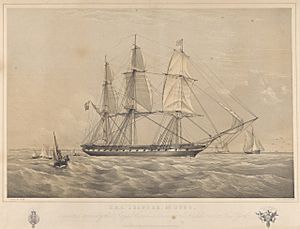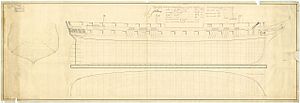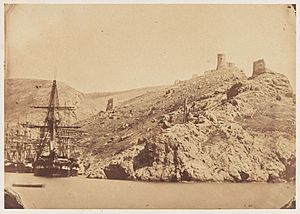HMS Leander (1848) facts for kids

H.M.S. Leander, 50 guns, appointed to convey the Royal Commissioners to the Exhibition at New York, artist and engraver Thomas Goldsworthy Dutton
|
|
Quick facts for kids History |
|
|---|---|
| Name | HMS Leander |
| Builder | HMNB Portsmouth, Portsmouth, United Kingdom |
| Laid down | 4 July 1843 |
| Launched | Floated out 8 March 1848 |
| Christened | 8 March 1848 |
| Commissioned | 28 September 1849 |
| Decommissioned | 17 November 1866 |
| In service | 1848? |
| Out of service | 1867 |
| Reclassified | 26 February 1861 as steam frigate |
| Refit | 21 January 1860 for conversion to screw propulsion |
| Stricken | 17 November 1866 |
| Honours and awards |
Crimean War |
| Fate | Sold to Castle & Beech April 1867 for BU at Charlton, London |
| General characteristics | |
| Class and type | 50-gun fourth rate |
| Type | Frigate |
| Tons burthen |
|
| Length |
|
| Beam | 16 feet (4.9 m) |
| Installed power | 400 ihp. |
| Propulsion | sail then sail & Steam |
| Sail plan | Full-rigged ship |
| Speed | 9.703 knots under steam power |
| Crew | 525 as Screw Frigate |
| Armament | 50 guns as Sailing Frigate and 51 guns as Screw Frigate |
HMS Leander was a powerful warship, a 50-gun frigate. This means it was a medium-sized sailing warship. It was part of the Royal Navy, Britain's navy, and played a role in the Crimean War.
Originally, Leander was a sailing ship, active from 1849 to 1856. During the Crimean War, it was the main ship (called a flagship) for Rear-Admiral Charles Howe Fremantle in the Black Sea. This period lasted from January 1855 to September 1856.
Later, the ship was updated in 1861 to become a "screw frigate." This meant it could use both sails and a steam engine. From 1863 to 1866, it served as a flagship in the Pacific Ocean. Leander returned to Britain in November 1866 and was taken apart in 1867.
Contents
Building and Launching Leander
HMS Leander was ordered on July 4, 1843. It was built at the HMNB Portsmouth, a major naval shipyard. The ship was made of wood.
Its design came from Richard F. S. Blake. He was the master shipwright, or chief shipbuilder, at Portsmouth from 1830 to 1835. Leander was launched, or "floated out," on March 8, 1848.
Early Years of Service
Leander began its first official service on September 28, 1849. Its first commander was Captain Sidney Dacres. He came from a family with a long history in the navy.
Captain Dacres later became an admiral and even the First Naval Lord. This was a very important job in the Royal Navy. He commanded Leander until June 3, 1852.
Leander in the Crimean War
Captain George King took command of Leander from June 1852 to November 1854. In May 1853, the ship carried royal commissioners to an exhibition in New York City.
After that, Captain King sailed Leander to the Mediterranean Sea and then to the Black Sea. This was at the beginning of the Crimean War. King later became the Commander-in-Chief of the China Station.
Flagship Duty in the Black Sea
On January 6, 1855, Leander became the flagship for Rear-Admiral Charles Howe Fremantle. This meant it was the admiral's main ship. At this time, Captain William Peel was in command of Leander.
The ship helped manage naval transport from Balaklava on the Crimean Peninsula. This was a very important job during the Crimean War. Captain Peel also served with the Naval Brigade on land.
Captain Peel's Bravery
During the Siege of Sevastopol in October 1854, Captain Peel showed great courage. He picked up a live shell with a burning fuse and threw it away. The shell exploded right after it left his hands.
For this brave act, he was given the Victoria Cross (VC). This is Britain's highest award for bravery. You can see his Victoria Cross at the National Maritime Museum in Greenwich, England.
Later Commanders in the War
In August 1855, William Moorsom became Leander's captain. The ship remained Admiral Fremantle's flagship. The final captain during the Crimean War was Edward Rice.
He commanded Leander from January 1856 until the ship finished its service on September 23, 1856. Rice later became a full Admiral in the Royal Navy.
Service in the Pacific Ocean
On February 16, 1861, Leander was taken out of the dockyard. It had been updated to become a screw-propelled steam frigate. This meant it now had a steam engine to help it move, along with its sails.
The ship was also given new weapons. It had thirty 8-inch shell guns and twenty 32-pounder guns. It also had a powerful 68-pounder gun at the front.
Journey to the Pacific
Leander's next period of service began on May 23, 1863. Commodore Thomas Harvey was its new commander. The ship sailed to the Pacific Station. This was a naval base in the Pacific Ocean.
There, Leander served as the flagship for the Southern Division. Its base was in Valparaíso, Chile.
Bombardment of Valparaíso
On January 1, 1866, Commodore Michael de Courcy became the new captain. Leander remained the flagship for the Pacific Station Southern Division. De Courcy Island, off Canada's west coast, is named after him.
Under his command, Leander was present during the Bombardment of Valparaíso on March 31, 1866. During this event, Spanish forces attacked the city. British property was damaged.
End of Service
Leander's final captain was William Dowell. He took command on June 16, 1866. He sailed the ship back to Britain.
Leander was officially taken out of service on November 17, 1866. In April 1867, it was sold to a company called Castle & Beech in Charlton, London. They took the ship apart for its materials.
Like many ships that were converted to use both sails and steam, Leander became outdated quickly. It only had one period of service after its steam engine was added.



